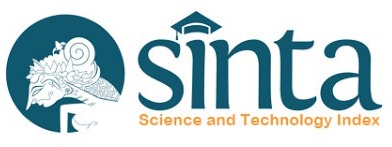Karakteristik Kimia Dan Organoleptik Produk Pabudu Telur Ikan Belanak (Crenemugil seheli) Di Kecamatan Pahunga Lodu
Abstract
Pengolahan ikan belanak masyarakat pesisir Kecamatan Pahunga Lodu hanya memanfaatkan daging untuk dijadikan produk olahan. Sedangkan, bagian lain misalnya telur diolah menjadi pabudu. Pabudu merupakan jenis olahan produk perikanan tradisional yang melibatkan proses penggaraman, fermentasi dan pengasapan tradisional. Penelitian ini bertujuan untuk menganalisis karakteristik kimia seperti proksimat, asam lemak dan asam amino pabudu. Penelitian ini diawali dengan mengumpulkan informasi pembuatan pabudu dengan wawancara mendalam terhadap masyarakat pesisir Kecamatan Pahunga Lodu. Tahap selanjutnya ialah pembuatan pabudu (penggaraman, fermentasi, pengasapan). Pabudu yang dihasilkan lalu dianalisis proksimat, asam lemak dan asam amino. Hasil penelitian menunjukkan kandungan proksimat pabudu yakni kadar air 39,39%, abu 12,52%, lemak 13,37%, protein 27,52%, dan karbohidrat 7,20%. Selain itu, pabudu juga teridentifikasi 30 jenis asam lemak yang terbagi atas 2 kelompok utama yakni asam lemak jenuh (saturated fatty acid/SFA) dengan persentase mencapai 5,64% dan asam lemak tak jenuh (unsaturated fatty acid) 4,34%. Sedangkan monounsaturated fatty acid (MUFA) mencapai 1,89% dan polyunsaturated fatty acid (PUFA) sebesar 2,44%. Produk terlur ikan pabudu mengandung 15 jenis asam amino yang terdiri dari asam amino esensial 10,25% dan asam amino non esensial mencapai 10,52%. Karakteristik organoleptik produk telur ikan pabudu yakni berkisar pada kategori “suka” hingga “sangat suka”. Adapun rerata skor pada masing-masing varibel organoleptik yakni warna telur ikan pabudu memiliki skor (nilai sensori) mencapai 6,13 (sangat suka), aroma 5,06 (suka), rasa 5,87 (suka), dan tekstur 6,27 (sangat suka).
ABSTRACT
The coastal communities of Pahunga Lodu District, mullet fish processing primarily utilizes the meat for creating value-added products. Conversely, other parts, such as the eggs, are transformed into ‘pabudu,’ a traditional fishery product derived through age-old methods of salting, fermenting, and smoking. The objective of this study is to examine the chemical properties of pabudu, including its proximate composition, fatty acids, and amino acids. The research commenced with gathering insights on pabudu production through comprehensive interviews with the local coastal populace. Subsequent to information collection, the production of pabudu ensued, encompassing salting, fermentation, and smoking phases. Analyses conducted on the finished pabudu revealed a proximate composition of 39.39% water, 12.52% ash, 13.37% fat, 27.52% protein, and 7.20% carbohydrates. Additionally, the study identified 30 fatty acids in pabudu, categorized into two primary groups: saturated fatty acids (SFAs) at 5.64% and unsaturated fatty acids at 4.34%. Within these, monounsaturated fatty acids (MUFAs) constituted 1.89%, and polyunsaturated fatty acids (PUFAs) 2.44%. The pabudu fish egg product encompasses 15 amino acids, with essential amino acids making up 10.25% and non-essential amino acids 10.52%. Organoleptic evaluation of pabudu fish eggs ranged from ‘like’ to ‘very like’ categories. The average scores for the organoleptic attributes were as follows: color received a sensory value of 6.13 (liked very much), aroma 5.06 (liked), taste 5.87 (liked), and texture 6.27 (really liked)
Keywords
Full Text:
PDF (Bahasa Indonesia)References
[AOAC] Association of Official Analytical Chemist. (2012). Official Method of Analysis of The Association of Official Analytical of Chemist. Arlington (US): The Association of Official Analytical Chemist, Inc
[BSN] Badan Standardisasi Nasional. (2010). Telur Ikan Terbang Kering: SNI 2720.1:2010. Jakarta (ID): Dewan Standardisasi Nasional
Ahillah, N., Rusdanillah, A., & Afiana, W. (2017). Pengaruh konsentrasi garam pada fermentasi ikan wader (Rasbora lateristriata). Bioedukasi: Jurnal Pendidikan Biologi, 10(2),12-17. doi : 10.20961/bioedukasi-uns.v10i2.11566
Azara, R., & Saidi, I. A. (2020). Buku Ajar Mikrobiologi Pangan. Bandung (ID) : Umsida Press
Beddih, M. L. O. A., El Cafsi, M., Marzouk, B., Zarrouk, K., & ROMDHANE, M. S. (2004). Etude comparative des lipides de la boutargue du mulet à grosse tête (Mugil cephalus, linné 1758) de l’océan Atlantique: Nouakchott (Mauritanie) et de la mer Méditerranée: Tunis (Tunisie). INSTM Bulletin: Marine and Freshwater Sciences, 31, 69-74.
Bunga, S., Ahmmed, M. K., Carne, A., & Bekhit, A. E. D. A. (2021). Effect of salted-drying on bioactive compounds and microbiological changes during the processing of karasumi-like Chinook salmon (Oncorhynchus tshawytscha) roe product. Food Chemistry, 357, 129780. doi : 10.1016/j.foodchem.2021.129780
Caredda, M., Addis, M., Pes, M., Fois, N., Sanna, G., Piredda, G., & Sanna, G. (2018). Physico-chemical, colorimetric, rheological parameters and chemometric discrimination of the origin of Mugil cephalus' roes during the manufacturing process of Bottarga. Food Research International, 108, 128-135. doi : 10.1016/j.foodres.2018.03.039
Çelik, U., Altınelataman, C., Dinçer, T., & Acarlı, D. (2012). Comparison of fresh and dried flathead grey mullet (Mugil cephalus, Linnaeus 1758) caviar by means of proximate composition and quality changes during refrigerated storage at 4±2 C. Turkish Journal of Fisheries and Aquatic Sciences, 12(1). doi : 10.4194/1303-2712-v12_1_01
Corrias, F., Atzei, A., Giglioli, A., Pasquini, V., Cau, A., Addis, P., & Angioni, A. (2020). Influence of the technological process on the biochemical composition of fresh roe and bottarga from Liza ramada and Mugil cephalus. Foods, 9(10), 1408. doi : 10.3390/foods9101408
El-Sebaiy, L. A., & Metwalli, S. M. (1989). Changes in some chemical characteristics and lipid composition of salted fermented Bouri fish muscle (Mugil cephalus). Food Chemistry, 31(1), 41-50. doi : 10.1016/0308-8146(89)90149-0
Hasan, B., Desmelati, D., Iriani, D., Nugroho, T., Arifin, M. A., & Syatapahana, A. (2015). Aktivitas enzim protease dan lipase viscera ikan kembung (Restrelliger sp) pada pH dan konsentrasi garam berbeda. Berkala Perikanan Terubuk, 43(2), 68-76.
Hasanah, R. (2013). Isolasi dan identifikasi bakteri dari produk fermentasi telur ikan tambakan (Helostoma temminckii CV). Jurnal Ilmu Perikanan Tropis, 19(1), 40-44.
Henggu, K. U., & Nurdiansyah, Y. (2021). Review dari metabolisme karbohidrat, lipid, protein, dan asam nukleat. QUIMICA: Jurnal Kimia Sains dan Terapan, 3(2), 9-17. doi : 10.33059/jq.v3i2.5688
Henggu, K. U., Meko, A. U., Pesulima, W., Manteu, S. H., Benu, M. J. R., & Tega, Y. R. (2020). Kajian pra kondisi dan konsentrasi asap cair yang berbeda terhadap mutu produk ikan Tembang (Sardinella fimbriata) asap cair. Jambura Fish Processing Journal, 2(2), 57-67. doi : 10.37905/jfpj.v2i2.5947
Intarasirisawat, R., Benjakul, S., & Visessanguan, W. (2011). Chemical compositions of the roes from skipjack, tongkol and bonito. Food chemistry, 124(4), 1328-1334. doi : 10.1016/j.foodchem.2010.07.076
Kari, N. M., Ahmad, F., & Ayub, M. N. A. (2022). Proximate composition, amino acid composition and food product application of anchovy: a review. Food Research, 6(4), 16-29. doi: 10.26656/fr.2017.6(4).419
Karso, K., Wuryanti, W., & Sriatun, S. (2014). Isolasi dan karakterisasi kitinase isolat jamur akuatik kitinolitik KC3 dari kecoa (Orthoptera). Jurnal Kimia Sains dan Aplikasi, 17(2), 51-57. doi : 10.14710/interaksi.%25v.%25i.56-66
Khemis, I. B., Hamza, N., & Sadok, S. (2019). Nutritional quality of the fresh and processed grey mullet (Mugilidae) products: a short review including data concerning fish from freshwater. Aquatic Living Resources, 32, 2. doi : 10.1051/alr/2018026
Lyon, B. G. (1984). Effects of sodium chloride and sodium polyphosphate treatments on proximate composition, selected mineral content, and sensory properties of canned fowl. Poultry Science, 63(4), 664-672. doi : 10.3382/ps.0630664
Mahamad, P., Dahlan, W., Nungarlee, U., Petchareon, P., Chaovasuteeranon, S., Salae, K., ... & Nopponpunth, V. (2022). Effect of amino acids and taste components on the fermented fish sauce (Budu) from Thailand. Proceedings of The International Halal Science and Technology Conference, 14(1), 171-181. doi : 10.31098/ihsatec.v14i1.499.
Mol, S., & Turan, S. (2008). Comparison of proximate, fatty acid and amino acid compositions of various yypes of fish roes. International Journal of Food Properties, 11(3), 669–677. doi : 10.1080/10942910701611170
Mourniaty, A. Z. A., Nuringtyas, A. E., Larasati, A. P., Septian, F., Mulyana, I., Israwati, W., & Jabbar, M. A. (2019). Aspek biologi ikan belanak (Mugil Cephalus) di perairan teluk banten. Buletin Jalanidhitah Sarva Jivitam, 1(2), 81-87. doi : 10.15578/bjsj.v1i2.8423.
Ogodo, A. C., Ugbogu, O. C., Onyeagba, R. A., & Okereke, H. C. (2017). Effect of lactic acid bacteria consortium fermentation on the proximate composition and in-vitro starch/protein digestibility of maize (Zea mays) flour. American Journal of Microbiology and Biotechnology, 4(4), 35-43.
Rodrigo, J., Ros, G., Periago, M., López, C., & Ortuño, J. (1998). Proximate and mineral composition of dried salted roes of hake (Merluccius merluccius, L.) and ling (Molva molva, L.). Food Chemistry, 63(2), 221-225. doi : 10.1016/S0308-8146(98)00002-8
Rosa, A., Atzeri, A., Deiana, M., Melis, M. P., Loru, D., Incani, A., & Dessì, M. A. (2011). Effect of aqueous and lipophilic mullet (Mugil cephalus) bottarga extracts on the growth and lipid profile of intestinal Caco-2 cells. Journal of agricultural and food chemistry, 59(5), 1658-1666. doi : 10.1021/jf1034256
Rosa, A., Isola, R., Nieddu, M., & Masala, C. (2020). The role of lipid composition in the sensory attributes and acceptability of the salted and dried mullet roes (bottarga): A Study in human and animal models. Nutrients, 12(11), 3454. doi : 10.3390/nu12113454
Rosa, A., Scano, P., Atzeri, A., Deiana, M., & Falchi, A. M. (2013). Potential anti-tumor effects of Mugil cephalus processed roe extracts on colon cancer cells. Food and chemical toxicology, 60, 471-478. doi : 10.1016/j.fct.2013.08.009
Rustan, A. C., & Drevon, C. A. (2001). Fatty acids: structures and properties. Encyclopedia of Life Sciences, 1:7. doi: 10.1002/9780470015902.a0029198
Sulistijowati, R. (2018). Mekanisme Pengasapan Ikan. Gorontalo (ID): Universitas Negeri Gorontalo Press
Syandri, H. (2011). Kadar nutrisi limbah telur ikan bilih (Mystacoleucus padangensis blkr) sebagai sumber ransum pakan ikan. Jurnal Akuakultur Indonesia. 10(1): 74-80.
Waters AccQ Inc. (1993). Chemistry Package: Instruction Manual. USA (US): Millipore Corporation.
Yang, W., Shi, W., Qu, Y., Wang, Z., Shen, S., Tu, L., & Wu, H. (2020). Research on the quality changes of grass carp during brine salting. Food Science & Nutrition, 8(6), 2968-2983. doi : 10.1002/fsn3.1599.
DOI: https://doi.org/10.15578/jpbkp.v20i1.1045
Refbacks
- There are currently no refbacks.
JPBKP adalah Jurnal Ilmiah yang terindeks :
ISSN : 1907-9133(print), ISSN : 2406-9264(online)
This work is licensed under a Creative Commons Attribution-NonCommercial-ShareAlike 4.0 International License.








